
Greenwich is a town in south-east London, England, within the ceremonial county of Greater London. It is situated 5.5 miles (8.9 km) east-south-east of Charing Cross.

Greenwich Hospital was a permanent home for retired sailors of the Royal Navy, which operated from 1692 to 1869. Its buildings, initially Greenwich Palace, in Greenwich, London, were later used by the Royal Naval College, Greenwich and the University of Greenwich, and are now known as the Old Royal Naval College. The word "hospital" was used in its original sense of a place providing hospitality for those in need of it, and did not refer to medical care, although the buildings included an infirmary which, after Greenwich Hospital closed, operated as Dreadnought Seaman's Hospital until 1986.

The Royal Hospital Chelsea is an Old Soldiers' retirement home and nursing home for some 300 veterans of the British Army. Founded as an almshouse, the ancient sense of the word "hospital", it is a 66-acre (27 ha) site located on Royal Hospital Road in Chelsea, London. It is an independent charity and relies partly upon donations to cover day-to-day running costs to provide care and accommodation for veterans.
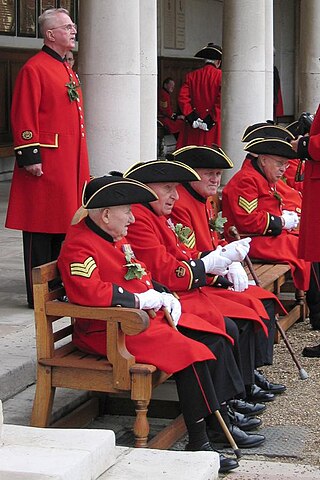
A Chelsea Pensioner, or In-Pensioner, is a resident at the Royal Hospital Chelsea, an Old Soldiers' retirement home and nursing home for former members of the British Army located in Chelsea, London. The Royal Hospital Chelsea is home to 300 retired British soldiers, male and female, and is located on Royal Hospital Road. Historically, the term "Chelsea Pensioner" applied more widely, referring to both In-Pensioners and Out-Pensioners who live elsewhere.
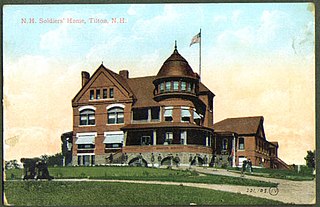
An old soldiers' home is a military veterans' retirement home, nursing home, or hospital, or sometimes an institution for the care of the widows and orphans of a nation's soldiers, sailors, and marines, etc.

The tricorne or tricorn is a style of hat that was popular during the 18th century, falling out of style by the early 1800s, though not called a "tricorne" until the mid-19th century. During the 18th century, hats of this general style were referred to as "cocked hats". At the peak of its popularity, the tricorne varied greatly in style and size, and was worn not only by the aristocracy, but also as common civilian dress, and as part of military and naval uniforms. Typically made from animal fiber, the more expensive being of beaver-hair felt and the less expensive of wool felt, the hat's most distinguishing characteristic was that three sides of the brim were turned up (cocked) and either pinned, laced, or buttoned in place to form a triangle around the crown. The style served two purposes: first, it allowed stylish gentlemen to show off the most current fashions of their wigs, and thus their social status; and secondly, the cocked hat, with its folded brim, was much smaller than other hats, and therefore could be more easily tucked under an arm when going inside a building, where social etiquette dictates that a gentleman should remove his hat. Tricornes with laced sides could have the laces loosened and the sides dropped down to provide better protection from the weather, sun, and rain.
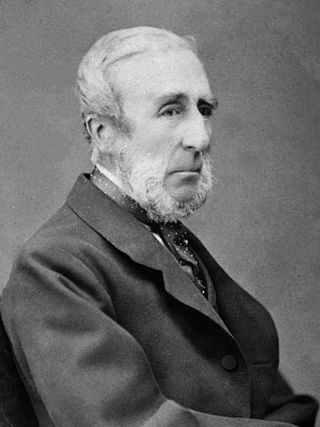
George Busk FRS FRAI was a British naval surgeon, zoologist and palaeontologist.

A sailor suit is a uniform traditionally worn by enlisted seamen in a navy or other governmental sea services. It later developed into a popular clothing style for children, especially as dress clothes and school uniforms.

The Chatham Chest was a fund set up in 1588 to pay pensions to disabled seamen from the Royal Navy. It was financed by regular deductions from seamen's pay, which were deposited in a chest held at Chatham Dockyard and disbursed upon proof of a sailor's disability. The fund ceased operation in 1803 when it was merged with an equivalent pension scheme run by Greenwich Hospital. The actual Chatham Chest has since been displayed at the National Maritime Museum in London and at the Mast House at Chatham Historic Dockyard.
The Seafarers Hospital Society, formerly the Seamen's Hospital Society, is a charity for people currently or previously employed by the British Merchant Navy and fishing fleets, and their families. It was established in 1821.

Admiral Sir Sydney Colpoys Dacres, was an officer of the Royal Navy who saw service during the Greek War of Independence, when he was involved in an attack on the Turkish forces at Morea, and later during the Crimean War. Born into a substantial naval dynasty during the Napoleonic Wars, he eventually rose to the rank of Admiral and became First Naval Lord. His only significant action as First Naval Lord was to press for the abolition of masts. He went on to be Visitor and Governor of Greenwich Hospital.

A Royal Naval Hospital (RNH) was a hospital operated by the British Royal Navy for the care and treatment of sick and injured naval personnel. A network of these establishments were situated across the globe to suit British interests. They were part of the Royal Naval Medical Service. The British Army equivalent was a Military Hospital, and in the 20th century a number of RAF Hospitals were also established.

East Greenwich Pleasaunce is a public park in East Greenwich, in south-east London. It is situated to the north side of the railway line between Maze Hill and Westcombe Park railway stations and south of the A206 Woolwich Road.

The Royal Hospital Haslar in Gosport, Hampshire, which was also known as the Royal Naval Hospital Haslar, was one of Britain's leading Royal Naval Hospitals for over 250 years. Built in the 1740s, it was reputedly the largest hospital in the world when it opened, and the largest brick-built building in Europe.

Sir George Biddlecombe was an English naval officer, hydrographer and author.
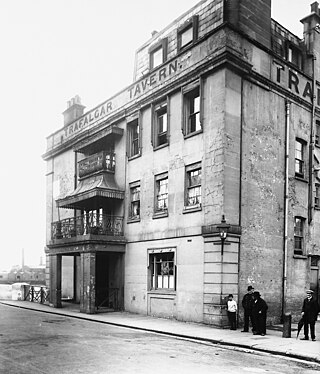
The Trafalgar Tavern is a Grade II listed public house at the north end of Park Row, Greenwich, London, on the south bank of the River Thames, east of and adjacent to the Old Royal Naval College. Built by architect Joseph Kay on the site of a previous tavern and opened in 1837, it operated until 1915, after which the building was used for other purposes, including as a working men's club and residential accommodation. The Tavern reopened in 1965, was refurbished in 1968, and gained listed building status in 1973. It is located within the eastern boundary of the Maritime Greenwich World Heritage Site, designated by UNESCO in 1997.

The Corps of Invalids was a British unit that provided garrison troops for the defence of England and Great Britain between 1688 and 1802. The men and officers were all veterans of the British Army chosen by the commissioners of the Royal Hospital Chelsea to serve in lieu of a place at the hospital or receipt of a pension. The corps was rapidly expanded or decreased in size as needs arose and played a key role in regulating the manpower requirements of the British Army. The corps was organised into a number of independent companies that were garrisoned at key points in the country, freeing up units of the regular army for service overseas. The men were generally those who were too old or wounded to serve in the regular forces and most served at least six years with the corps. In the early years they wore a grey uniform but later wore the same red coat with blue facings as worn by the patients of the Chelsea Hospital.
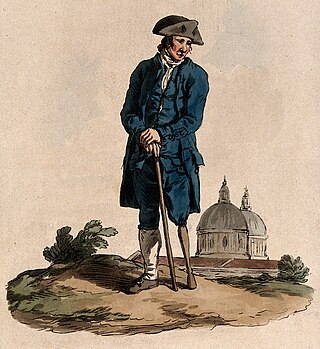
One-armed versus one-legged is a form of cricket in which one team has cricketers with only one arm while the members of the other team only have one leg.
Thomas Ashburton Picken, known professionally as T. Picken, was a Scottish-born watercolourist, engraver and lithographer working in England between around 1834 and 1875. He worked for the printing firm Day and Haghe for many years, and first came to notice for his lithograph of The Destruction of Both Houses of Parliament when he was only about 16 years old. Although there is no evidence that he travelled abroad, he produced many lithographs of foreign parts after paintings by other artists. He specialised in detailed images of landscape, architecture, events of war, and ships. He produced lithographs of SS Great Eastern and the laying of the Atlantic cable, and he illustrated books.

Admiral Edward Sparshott was an English officer of the Royal Navy, serving during the Napoleonic Wars. As midshipman on HMS Centaur, flagship of Sir Samuel Hood, he was present at the surrender of Madeira. As captain, he commanded HMS Prince Regent, and HMS Winchester, flagships of Sir Henry Blackwood and Sir Thomas Bladen Capel, besides HMS Rochfort as post-captain under Charles Marsh Schomberg. He retired as captain, and ended his life with the rank of retired admiral.


















